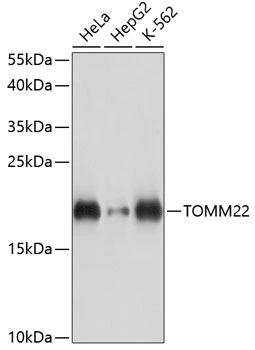TOMM22 antibody [1C9-2]
GTX10436
ApplicationsElectron Microscopy, ImmunoFluorescence, Western Blot, ImmunoCytoChemistry
Product group Antibodies
TargetTOMM22
Overview
- SupplierGeneTex
- Product NameTOMM22 antibody [1C9-2]
- Delivery Days Customer9
- Application Supplier NoteWB: 0.5-1.0 microg/ml. *Optimal dilutions/concentrations should be determined by the researcher.Not tested in other applications.
- ApplicationsElectron Microscopy, ImmunoFluorescence, Western Blot, ImmunoCytoChemistry
- CertificationResearch Use Only
- ClonalityMonoclonal
- Clone ID1C9-2
- Concentration1 mg/ml
- ConjugateUnconjugated
- Gene ID56993
- Target nameTOMM22
- Target descriptiontranslocase of outer mitochondrial membrane 22
- Target synonyms1C9-2, MST065, MSTP065, TOM22, mitochondrial import receptor subunit TOM22 homolog, mitochondrial import receptor Tom22, translocase of outer membrane 22 kDa subunit homolog, translocase of outer mitochondrial membrane 22 homolog
- HostMouse
- IsotypeIgG1
- Protein IDQ9NS69
- Protein NameMitochondrial import receptor subunit TOM22 homolog
- Scientific DescriptionTom22 has a negatively charged N-terminal region exposed to the cytosol, a putative transmembrane region, and a C-terminal intermembrane space region with little negative charge. The following functions can be assigned to the three domains of Tom22: the cytosolic N-terminal domain plays a dual role, specifically important for presequence binding; the intermembrane space domain provides a trans binding site for presequences, and the single membrane anchor of Tom22 is crucial for the integrity of the GIP (general import gene) complex. In the absence of this membrane anchor, the GIP complex dissociates into small core complexes containing a dimer of Tom40 and the three small Toms. A preprotein is stably arrested and accumulated in the GIP complex by Tom40 and Tom22.4 Such a 100 kDa core complex probably contains a single channel that retains the basic channel properties but is already open in the absence of preproteins. In contrast, in the presence of Tom22, the wild-type GIP complex contains tightly regulated channels (probably three channels). Tom22 apparently represents a component of the machinery that controls the gate. The cytosolic domains of Tom22 and Tom20 are believed to form the major part of a cis site, which mediates the import of all preproteins known to use the general import machinery of mitochondria. The preprotein is then routed through the Tom complex translocation channel and transferred to a trans site on the intermembrane space (IMS) side of the outer membrane. The inter-membrane space exposed segment of Tom40 and the C-terminal tail of Tom22 may contribute to the trans-site. Matrix-targeted proteins are further transferred to the matrix through Product Information import machinery in the inner membrane. The TOM complex of mammalian mitochondria resembles the fungal Tom complex, but is distinct from the plant TOM system. Thus, while unique components of the mammalian mitochondrial import system have been identified (e.g. TOM34 and metaxin), Tom22, and Tom37 have not been identified in plant mitochondria.
- Storage Instruction-20°C or -80°C,2°C to 8°C
- UNSPSC12352203
References
- Kozjak-Pavlovic V, Dian-Lothrop EA, Meinecke M, et al. Bacterial porin disrupts mitochondrial membrane potential and sensitizes host cells to apoptosis. PLoS Pathog. 2009,5(10):e1000629. doi: 10.1371/journal.ppat.1000629Read this paper





